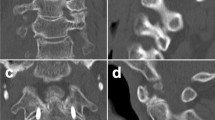Abstract
Purpose
To retrospectively evaluate the outcome of C1–2 transarticular screws combined with C1 laminar hooks fixation.
Methods
All patients underwent atlantoaxial fixation during a 5-year period. The surgical technique and treatment procedures were intensively reviewed and clinical symptoms, neurological function and imaging appearance were retrospectively evaluated.
Results
The clinical and radiology follow-up indicated a stable arthrodesis and clinical relief from symptoms for all patients. All patients with neurological defects improved an average of 1.33 grade at their most recent clinical assessment, P < 0.05; their average admission ASIA motor score, pin prick score and light touch score improved to an average follow-up ASIA score of 99.80 (99.83 ± 0.38), 111.83 (111.83 ± 0.45), and 111.89 (111.89 ± 0.32), respectively. No neurovascular impairment and case of implant failure were observed.
Conclusions
The C1–2 transarticular screws combined with C1 laminar hooks fixation is a reliable technique for atlantoaxial instability.





Similar content being viewed by others
References
Brooks AL, Jenkins EB (1978) Atlanto-axial arthrodesis by the wedge compression method. J Bone Joint Surg Am 60(3):279–284
Fassett DR, Harrop JS, Maltenfort M, Jeyamohan SB, Ratliff JD, Anderson DG, Hilibrand AS, Albert TJ, Vaccaro AR, Sharan AD (2007) Mortality rates in geriatric patients with spinal cord injuries. J Neurosurg Spine 7(3):277–281. doi:10.3171/SPI-07/09/277
Henriques T, Cunningham BW, Olerud C, Shimamoto N, Lee GA, Larsson S, McAfee PA (2000) Biomechanical comparison of five different atlantoaxial posterior fixation techniques. Spine (Phila Pa 1976) 25 (22):2877–2883
Dickman CA, Sonntag VK (1998) Posterior C1–C2 transarticular screw fixation for atlantoaxial arthrodesis. Neurosurgery 43(2):275–280 (discussion 280–271)
Gerbier G, Williams WT, Price PB, Guoxiao R, Vanderhaeghe G (1987) Charges and angular distributions of fast fragments produced in 3.2-TeV 16O collisions with Pb. Phys Rev Lett 59(22):2535–2538
Madawi AA, Casey AT, Solanki GA, Tuite G, Veres R, Crockard HA (1997) Radiological and anatomical evaluation of the atlantoaxial transarticular screw fixation technique. J Neurosurg 86(6):961–968
Paramore CG, Dickman CA, Sonntag VK (1996) The anatomical suitability of the C1–2 complex for transarticular screw fixation. J Neurosurg 85(2):221–224
Crisco JJ 3rd, Panjabi MM, Oda T, Grob D, Dvorak J (1991) Bone graft translation of four upper cervical spine fixation techniques in a cadaveric model. J Orthop Res 9(6):835–846. doi:10.1002/jor.1100090609
Grob D, Crisco JJ 3rd, Panjabi MM, Wang P, Dvorak J (1992) Biomechanical evaluation of four different posterior atlantoaxial fixation techniques. Spine (Phila Pa 1976) 17(5):480–490
Lapsiwala SB, Anderson PA, Oza A, Resnick DK (2006) Biomechanical comparison of four C1 to C2 rigid fixative techniques: anterior transarticular, posterior transarticular, C1 to C2 pedicle, and C1 to C2 intralaminar screws. Neurosurgery 58(3):516–521 (discussion 516–521). doi:10.1227/01.NEU.0000197222.05299.31
Melcher RP, Puttlitz CM, Kleinstueck FS, Lotz JC, Harms J, Bradford DS (2002) Biomechanical testing of posterior atlantoaxial fixation techniques. Spine (Phila Pa 1976) 27(22):2435–2440. doi:10.1097/01.BRS.0000031262.05676.E0
Smith MD, Kotzar G, Yoo J, Bohlman H (1993) A biomechanical analysis of atlantoaxial stabilization methods using a bovine model. C1/C2 fixation analysis. Clin Orthop Relat Res 290:285–295
Guo X, Ni B, Zhao W, Wang M, Zhou F, Li S, Ren Z (2009) Biomechanical assessment of bilateral C1 laminar hook and C1–2 transarticular screws and bone graft for atlantoaxial instability. J Spinal Disord Tech 22(8):578–585. doi:10.1097/BSD.0b013e31818da3fe
Heuer GG, Hardesty DA, Bhowmick DA, Bailey R, Magge SN, Storm PB (2009) Treatment of pediatric atlantoaxial instability with traditional and modified Goel-Harms fusion constructs. Eur Spine J 18(6):884–892. doi:10.1007/s00586-009-0969-x
Cornefjord M, Henriques T, Alemany M, Olerud C (2003) Posterior atlanto-axial fusion with the Olerud Cervical Fixation System for odontoid fractures and C1–C2 instability in rheumatoid arthritis. Eur Spine J 12(1):91–96. doi:10.1007/s00586-002-0470-2
Anderson RC, Kan P, Gluf WM, Brockmeyer DL (2006) Long-term maintenance of cervical alignment after occipitocervical and atlantoaxial screw fixation in young children. J Neurosurg 105(1 Suppl):55–61. doi:10.3171/ped.2006.105.1.55
Anderson RC, Ragel BT, Mocco J, Bohman LE, Brockmeyer DL (2007) Selection of a rigid internal fixation construct for stabilization at the craniovertebral junction in pediatric patients. J Neurosurg 107(1 Suppl):36–42. doi:10.3171/PED-07/07/036
Brockmeyer DL, York JE, Apfelbaum RI (2000) Anatomical suitability of C1–2 transarticular screw placement in pediatric patients. J Neurosurg 92(1 Suppl):7–11
Gluf WM, Schmidt MH, Apfelbaum RI (2005) Atlantoaxial transarticular screw fixation: a review of surgical indications, fusion rate, complications, and lessons learned in 191 adult patients. J Neurosurg Spine 2(2):155–163
Suchomel P, Stulik J, Klezl Z, Chrobok J, Lukas R, Krbec M, Magerl F (2004) Transarticular fixation of C1–C2: a multicenter retrospective study. Acta Chir Orthop Traumatol Cech 71(1):6–12
Kandziora F, Kerschbaumer F, Starker M, Mittlmeier T (2000) Biomechanical assessment of transoral plate fixation for atlantoaxial instability. Spine (Phila Pa 1976) 25 (12):1555–1561
Farey ID, Nadkarni S, Smith N (1999) Modified Gallie technique versus transarticular screw fixation in C1–C2 fusion. Clin Orthop Relat Res 359:126–135
Goel A, Gupta S (1999) Vertebral artery injury with transarticular screws. J Neurosurg 90(2):376–377
Abou Madawi A, Solanki G, Casey AT, Crockard HA (1997) Variation of the groove in the axis vertebra for the vertebral artery. Implications for instrumentation. J Bone Joint Surg Br 79 (5):820–823
Bloch O, Holly LT, Park J, Obasi C, Kim K, Johnson JP (2001) Effect of frameless stereotaxy on the accuracy of C1–2 transarticular screw placement. J Neurosurg 95(1 Suppl):74–79
Acknowledgments
This work was supported by National Natural Science Foundation of China (Item Number: 81101343).
Conflict of interest
None of the authors have received benefits for personal or professional use from a commercial party related directly or indirectly to the subject of this manuscript: e.g., honoraria, gifts, consultancies.
Author information
Authors and Affiliations
Corresponding author
Additional information
X. Guo and B. Ni contributed equally to the article.
Rights and permissions
About this article
Cite this article
Ni, B., Guo, X., Xie, N. et al. C1–2 transarticular screws combined with C1 laminar hooks fixation: a modified posterior atlantoaxial fixation technique and outcome in 72 patients. Eur Spine J 22, 260–267 (2013). https://doi.org/10.1007/s00586-012-2397-6
Received:
Revised:
Accepted:
Published:
Issue Date:
DOI: https://doi.org/10.1007/s00586-012-2397-6




